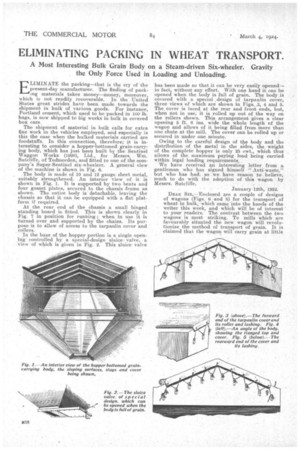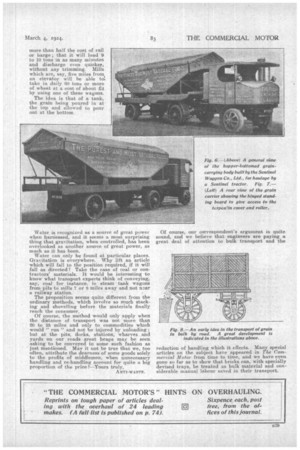ELIMINATING PACKING IN WHEAT TRANSPORT.
Page 22

Page 23

If you've noticed an error in this article please click here to report it so we can fix it.
A Most Interesting Bulk Grain Body on a Steam-driven Six-wheeler. Gravity the Only Force Used in Loading and Unloading.
ELIMINATE the packing—that is the cry of the present-day manufacturer. The finding of packing materials takes money—Money, moreover, which is not readily recoverable. In the United States great strides . have been made towards the shipment in bulk of various goo& For instance, Portland cement, which used to be packed in 100 lb. bags, is now shipped to big works in bulk in covered box cars.
The shipment of material in bulk calls for extra fine work in the vehicles employed, and especially is this the case when the bulked materials carried are foodstuffs. In this connection, therefore; it is interesting to consider a hopper-bottomed grain-carrying body, which has just been built by the Sentinel Waggon Works (1920), Ltd., for Messrs. Wm. Sutcliffe, of Todmorden, and fitted to one of the company's Super-Sentinel six-wheelers. A general view of the machine is shown in Fig. 6.
The body is made of 10 and 12 gauge sheet metal, suitably strengthened. An interior view of it is shown in Fig. I. It is supported by two bents and four gusset plates, secured to the chassis frame as shown. The entire body is detachable, leaving the chassis so that it can be equipped with a -flat platform if required.
At the rear end of the chassis a small hinged standing board is fitted. This is shown clearly in Fig. 7 in position for running ; when in use it is turned over and supported by the chains. Its purpose is to allow of access to the tarpaulin cover and • rollers.
In the base of the hopper portion is a single opening controlled by a special-design sluice valve, a view of which is given in Fig. 2. This sluice valve
has been made so that it can be very easily opened— in faa, without any effort. With one hand it can be opened when the body is full of grain. The body is covered with a special _design of tarpaulin cover, three views of which are shown in Figs.. 3, 4 and 5. The, cover is laced at the rear and front ends, but, when not in use, it is roiled up out of the way on the rollers shown. This arrangement gives a clear opening 5 ft. 6 ins, wide the whole length of the wagon and allows of it being filled from more than one chute at the mill. The cover can be rolled up or secured in under one minute.
Owing to the careful design of the body and the distribution of the metal in the sides, the weight of the complete hopper is only 25 cwt., which thus allows of the maximum paying load beingcarried within legal loading requirements, We have received an interesting letter from a gentleman -who has signed himself "Anti-waste," but who has had, so we have reason to believe, much to do with the adoption of this wagon by Messrs. Sutcliffe.'
• January 12th, 1924. DEAR Sin,—Enclosed are a couple of designs of wagons (Figs. 6 and 8) for the transport of wheat in bulk, 'which came into the hands of the writer this week, and which will be of interest ' to your readers. The contrast between the two wagons is most striking. • To mills which are favourably situated the new wagon will revolutionize the method of transport of grain. It is claimed that the wagon will carry grain at little
more than half the cost of rail or barge; that it will load 9 to 10 tons in as many minutes and discharge even quicker, without any trimming. Mills which are, say, five miles from an elevator will be able to take in daily 60 tons or more of wheat at a cost of about £4 by using one of these wagons.
The idea is that of a tank, the grain being: poured in at the top and allowed to pour out at the bottom.
Water is recognized as a source of great power when harnessed, and it seems a most surprising thing that gravitation, when controlled, has been overlooked as another source of great power, as much as it has been.
Water can only be found at particular places. Gravitation is everywhere. Why lift an article which will fall to the position required, if it will fall as directed? Take the case of coal or contractors' materials. It would be interesting to know what transport experts think of conveying, say, coal for instance, in steamtank wagons from pits to mills 7 or 8 miles away and not near a railway station.
The proposition seems quite different from the ordinary methods, which involve so much stacking and shovelling before the materials finally reach the consumer.
Of course, the method would only apply when the distance of transport was not more than 20 to 25 miles and only to commodities which would " run " and not be injured by unloading but at the pits, docks, stations, wharves and yards on our roads great heaps may be seen asking to be conveyed in some such fashion as just mentioned. May it not be true that we, too often, attribute the dearness of some goods solely to the profits of middlemen, when unnecessary handling and re-handling account for quite a big proportion of the price?----Yours truly,
reduction of handling which it effects. Many special articles on the subject have appeared in Tile Commercial Motor from time to time, and we have even gone so far as to show that bricks can, with specially devised trays, be treated as bulk material and considerable manual labour saved in their transport.






























